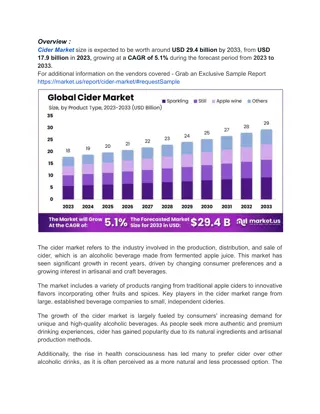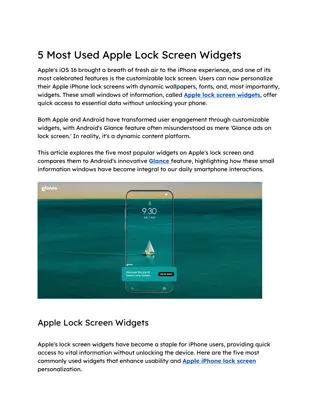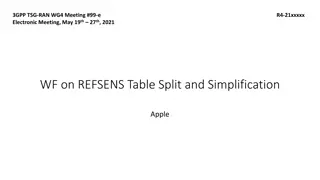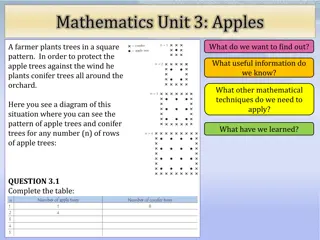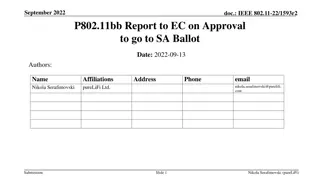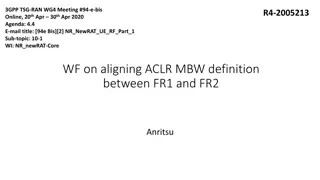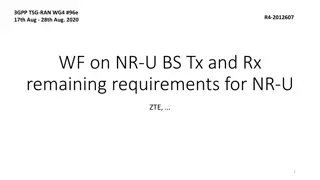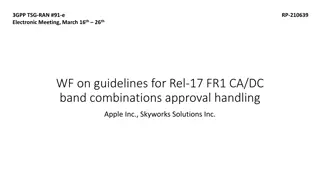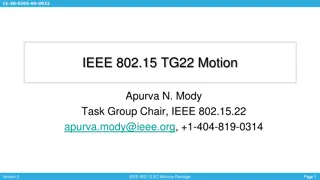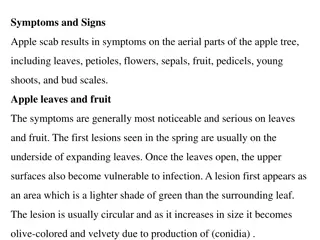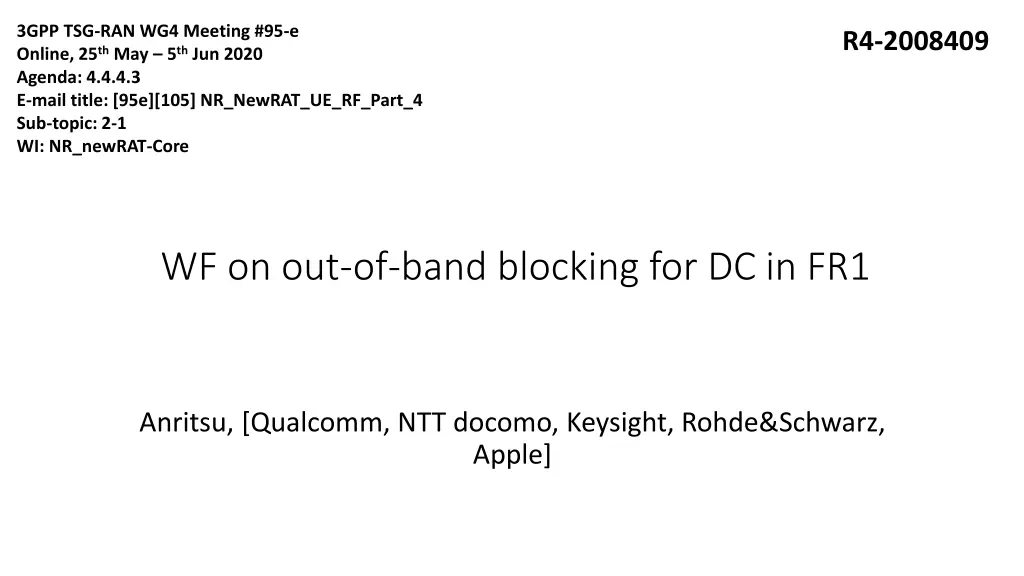
Addressing Out-of-Band Blocking in FR1 for NR NewRAT UE RF Part 4
Explore the discussions and proposed solutions for addressing out-of-band blocking issues in FR1 for NR NewRAT UE RF Part 4, focusing on UL power levels and EN-DC requirements. Dive into the considerations and alternatives presented by key companies.
Uploaded on | 0 Views
Download Presentation

Please find below an Image/Link to download the presentation.
The content on the website is provided AS IS for your information and personal use only. It may not be sold, licensed, or shared on other websites without obtaining consent from the author. If you encounter any issues during the download, it is possible that the publisher has removed the file from their server.
You are allowed to download the files provided on this website for personal or commercial use, subject to the condition that they are used lawfully. All files are the property of their respective owners.
The content on the website is provided AS IS for your information and personal use only. It may not be sold, licensed, or shared on other websites without obtaining consent from the author.
E N D
Presentation Transcript
3GPP TSG-RAN WG4 Meeting #95-e Online, 25th May 5th Jun 2020 Agenda: 4.4.4.3 E-mail title: [95e][105] NR_NewRAT_UE_RF_Part_4 Sub-topic: 2-1 WI: NR_newRAT-Core R4-2008409 WF on out-of-band blocking for DC in FR1 Anritsu, [Qualcomm, NTT docomo, Keysight, Rohde&Schwarz, Apple]
Background Background In RAN4 #94-e, a testability issue with the out of band blocking requirement for FR1 EN-DC UE was reported by [2]. At first the issue was reported due to a lack of receiver dynamic range within the test equipment against two uplink signals which have approximately 60 dB power difference. And the proposed solutions for this issue are as follows. Option 1: PCMAX_L 4 dB for both E-UTRA and NR UL Option 2: PCMAX_L 7 dB for both E-UTRA and NR UL Option 3: PCMAX_L 4 dB (UL for the source of IMD) and PCMAX_L [14] dB (UL whose DL is being tested) Later in RAN4 #94-e-bis, supplemental explanations were provided [3] and it turned out the route cause is rather an inconsistency of EN-DC requirement between other similar test cases such as single carrier or Intra/ Inter-band CA case. 2
Background Background Apart from a difference of RAT (E-UTRA or NR) , as a similar requirement, existing measurement condition of NR OoBB test case is as follows. The same condition can be seen with the E-UTRA inter-band CA case, too. 3
Open issues Open issues There are two remaining issues after the 1st round discussions of #95-e. Alternatives based on the company views are as follows. Issue 1) UL power level whose DL is being tested alternative 1-1: PCMAX_L,c 14 dB (original proposal in [4][6]) alternative 1-2: PCMAX_L,c 7 dB (condition defined in TS38.101-1 as inter-band CA case) alternative 1-3: PCMAX_L,c 29 dB (preference of one UE vendor and proposed by one TE vendor) However from the view point of consistency with existing requirements, alt.1-3 shall be eliminated unless a difference of EN-DC and NR stand-alone case is explained. Issue 2) alternative 2-1: PCMAX_L,c 4 dB (1UL case to be applied only to E-UTRA UL power) alternative 2-2: PCMAX_L,c 7dB (consistent with 2UL inter-band CA cases) UL power level for the source of IMD 4
Open issues Open issues Consideration with Issue 2) - alternative 2-1 To apply PCMAX_L,c 4 dB as UL power level, there is a need to clarify an assumption with the EN-DC mode on which occasion 1UL transmission applies. Case1) Standalone mode of NR or only E-UTRA mode with EN-DC UE, or Case2) only 1UL from E-UTRA and a call drop is happening with NR during the EN-DC mode. In the case 1) above, the test condition and requirement for 1UL is already covered by TS38.101-1, or TS 36.101. Same test condition with the 2UL CA case (Pcmax-7dB for both 2UL) can be defined as a normal EN-DC operation. In the case 2) above, is there a case if the behavior of EN-DC UE is different from standalone 2UL CA UE, and E-UTRA UL is transmitted with Pcmax-4dB while both Rx ports are active (Tx is not sent from NR)? If yes, set Pcmax-4dB for E-UTRA as a source of IMD. Here assuming there is no case that only NR UL is sent during EN-DC mode. 5
Way forward Way forward Companies are encouraged to study the actual behavior of the EN-DC UE and discuss which combination of following UL power level should be applied as the source of IMD during the EN-DC mode at the #96-e meeting. case a) PCMAX_L,c 4 dB for E-UTRA and PCMAX_L,c 7 dB for NR case b) PCMAX_L,c 7 dB for both E-UTRA and NR Either alternative 1 or 2 below will be down selected depending on the outcome of the study above. alternative 1: PCMAX_L,c 4 dB (E-UTRA UL for the source of IMD) and PCMAX_L,c 14 dB (NR UL whose DL is being tested) or, PCMAX_L,c 7 dB (NR UL for the source of IMD) and PCMAX_L,c 7 dB (E-UTRA UL whose DL is being tested) alternative 2: PCMAX_L,c 7 dB for both E-UTRA and NR UL Due to the higher output power the introduction of intermodulation products shall be considered for the definition of out-of-band blocking exceptions in the specification. 6
Reference Reference [1] R4-1815052, OBB for inter band EN-DC , NTT docomo, inc., RAN4 #89, Spokane, USA [2] R4-2000439, Testability issue with OoBB for FR1 EN-DC UE , Anritsu Corp., RAN4 #94-e, Online [3] R4-2003327, Testability issue with OoBB for FR1 EN-DC UE (2) , Anritsu corp., RAN4 #94-e-bis, Online [4] R4-2003328, Draft CR to out-of-band blocking for DC in FR1 , Anritsu corp., RAN4 #94-e-bis, Online [5] R4-2005686, Email discussion summary for [94e Bis][2] NR_NewRAT_UE_RF_Part_1 , Moderator (Apple Inc.), RAN4 #94-e-bis, Online [6] R4-2006146, CR to out-of-band blocking for DC in FR1 , Anritsu corp., RAN4#95-e, Online [7] R4-2008295, Email discussion summary for [95e][105] NR_NewRAT_UE_RF_Part_4 , Moderator (Apple Inc.), RAN4#95-e, Online 7





